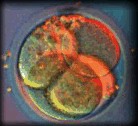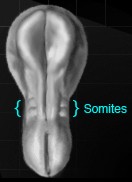Fertilization
Fertilization is a process of many steps over a 24-hour period. It begins as a sperm binds with the protein receptors on the surface of the newly-ovulated egg in a fallopian tube. The binding causes the reactions that draw the sperm into the egg cell.
 Cell Division
Cell DivisionThe single large cell containing the two sets of chromosomes begins to divide into more and more smaller cells. Simultaneously, the dividing zygote travels down the fallopian tube and, in 3-4 days after fertilization, enters the uterus. The cells, which have continued to divide, organize themselves on the outside of a cavity that forms in the middle of the mass. The entire structure is called a blastocyst. The external layer of cells eventually forms the placenta and the internal layer forms the embryo.
Organization and Axes
Initial cell division and other early activities of the zygote are controlled by the substances in the egg that came from the mother. Subsequently, the new individual's own genes, inherited from the parents, begin to control development. The head and tail axis, front and back axis, and left and right orientation of the future individual are established by internal chemical signals.
Germ Layers
At about 13 days after ovulation, the placenta establishes a connection with the mother. Cells begin to migrate to the center of the embryo, and, in addition to the initial ectoderm and endoderm cell layers, form a third mesoderm cell layer. From these three layers develop all the organs of the body.
 Organogenesis
OrganogenesisBy three weeks, the head and nervous system are recognizable in their early stages, as well as a tubular heart that begins contractions. Initially plenipotent stem cells have begun differentiation along the pathway to specialized cell types of the developed organism. The somites and the phryngeal arches reveal the segmentation of the human body that it shares with its vertebrate cousins.
Continuation
Through the first trimester, all the organ systems are established. The various parts of the body are recognizable, such as eyes, ears, arms, legs, etc. In the second two trimesters, organs and tissues continue to differentiate and both size and weight increase. The lungs and the respiratory system complete development only just before birth. The brain develops extensively through the rest of the fetal period and does not complete its differentiation until after puberty.
Summary
The many changes that occur during embryological development are controled initially by maternal substances deposited in the egg before ovulation and subsequently by the genes inherited by the offspring. Development is affected by the internal environment of the mother, by her eating, drinking, and activity. All mammals develop from a fertilized egg. The developmental instructions in the egg and zygote determine whether the final product is a human, a chimpanzee, or some other mammal.
Excerpted and adapted from: Embryonic Development: Getting Started, The Visible Embryo